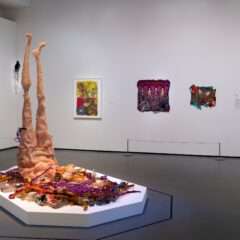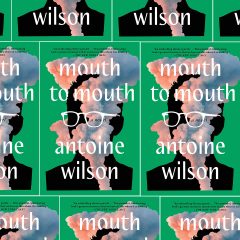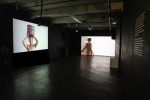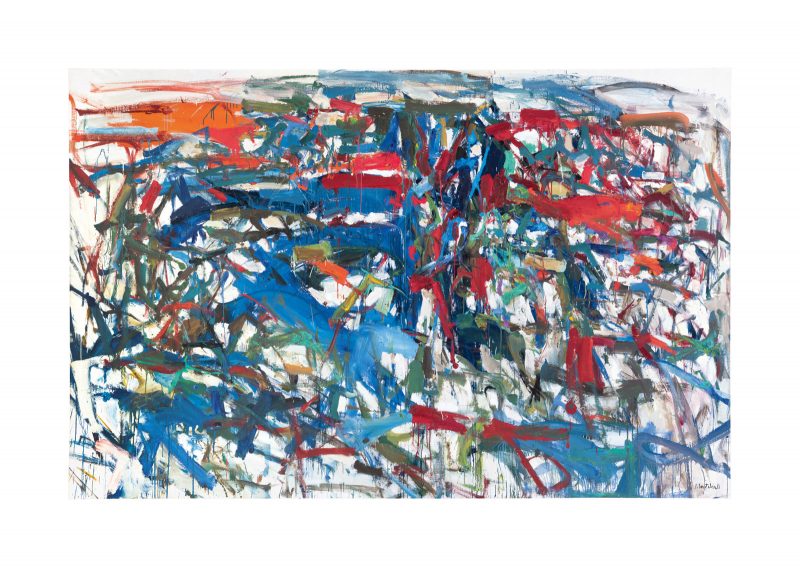
I admit it—I love expressive color and brushwork and abstract painting. It was therefore more a personal desire than a professional one to see the Joan Mitchell exhibition at the Baltimore Museum of Art (BMA). It features 70 works that range from early paintings and drawings to major large works as well as early photographs and archival materials. With high expectations, though secretly considering the possibility of disappointment, I traveled to Baltimore. The museum was busy; clearly there are other lovers of abstract painting out there. Although I have a basic affinity for the style, I was simply astonished by the show. It really is that good.
Some background: The BMA has been focusing on women artists since 2019. Viewers might think about the Joan Mitchell exhibition within the context of that decision, but it would be a mistake to see her as only another example of an exceptional “woman artist.” There is a judgment that the descriptor suggests, especially for women of her time. Mitchell’s work stands alongside abstract paintings by all artists of the period and is relevant today, especially for any painter interested in expressive color, the materiality of paint, and bravura brushwork. And there are quite a lot of people who admire her work for these reasons as well as for Mitchell’s tenacity, succeeding in a male-dominated art world.
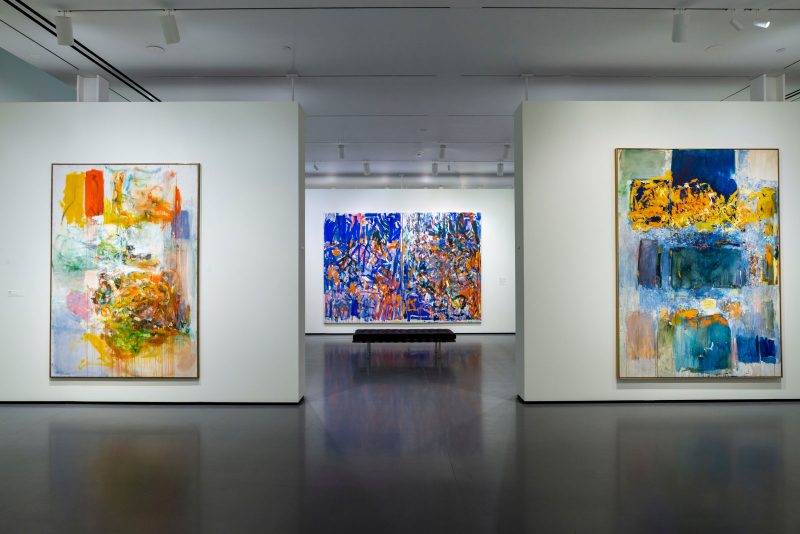
The curatorial team includes Katy Siegel, Senior Programming and Research Curator at the Baltimore Museum of art and Eugene V. and Clare E. Thaw Endowed Chair in Modern American Art at Stony Brook University, New York, and Sarah Roberts, the Andrew W. Mellon Foundation Curator and Head of Painting and sculpture at the San Francisco Museum of Modern Art (SFMOMA). Not only have they organized a remarkable exhibition, but they also have produced an exhaustive catalog through which they examine Mitchell’s career, seeing her as a “great artist.” They state that they “seek to recognize what Mitchell achieved by bringing to her art the deep scholarly consideration it has always called for, the kind that has been largely reserved for a tiny number of white, male artists.”* There are multiple authors who contribute essays that range from her early years to her time living in France, and some that concentrate on one work, or the effect of poetry on her paintings. The exhibition and accompanying catalog are a revelation, and both, dare I say it, are beautiful.
Mitchell has a fascinating biography, which is examined and connected to her work as an artist both in the catalog, and to some extent in the labels for the archival materials and wall texts included in the exhibition. She had the advantage of family money and status, but along with that came social expectations that she eventually transgressed. She grew up in Chicago reading and writing poetry, attending ballet and concerts, and visiting the great museums of the city. She began taking art classes while a child at the Chicago Art Institute, where she enrolled in the School of the Art Institute of Chicago in 1944 after her time at Smith College, eventually earning an M.F.A. from the school in 1949. She traveled to Mexico and Paris and spent time in Brooklyn, moving to NYC in 1950. Her mature artistic life took place in both New York and Paris.
Mitchell steeped herself in both art history and contemporary art, joining the circle of artists who frequented the Cedar Tree Tavern. She admired the work of Piet Mondrian, Henri Matisse, and Wassily Kandinsky and also that of Willem de Kooning, Franz Kline, and Philip Guston.** Mitchell’s first solo exhibition in New York took place in 1952 at the New Gallery, located in the Algonquin Hotel. Although in 1955 she left behind the gridded structure of French painting in her own work, she decided to move to France in 1959.*** Her career took place in both countries, but in many ways her transatlantic practice separated her from each. One of the early mature works, “To the Harbormaster,” suggests a view of the Atlantic Ocean, the site of her many crossings. It is, too, the subject of a poem of the same year by her close friend, Frank O’Hara.
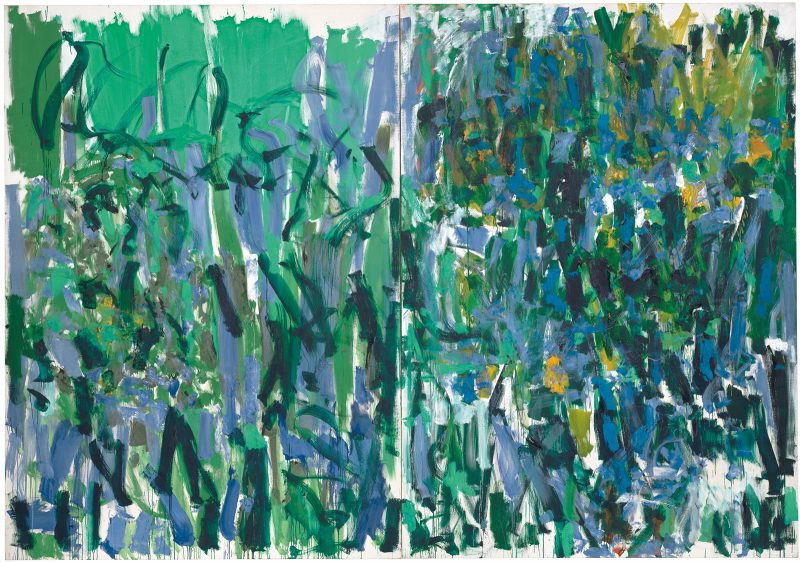
In 1967, Mitchell purchased a cottage on a two-acre estate, in Vétheuil, near Giverny, taking her out of the mainstreams of both Paris and New York. Discussion of the complex relationship between French and American painting of the period and Mitchell’s chosen outsider status is discussed in the catalog. Her property included a view of the Seine and extensive gardens; Monet lived there from 1878-1881. “Sans Pierre,” from 1969, is a large canvas that reflects both the greater size of her new studio space and the nature that surrounded her in the countryside. She grew to enjoy the seasonal changes. A diptych, “No Rain,” suggests her connection to Van Gogh’s paintings. She kept a postcard of his “No Rain” pinned to the wall of her studio.**** The more intense green in Mitchell’s image possibly also reflects the return of precipitation following a dry summer. It underscores how much of a colorist she was too. Balancing areas of dense overlapping brushwork with large flat zones of color and bits of white here and there, these paintings demonstrate a sophisticated brushwork, which has a kind of abandoned exuberance, but is simultaneously astutely controlled.
A later work, “Weeds” further demonstrates this decision making where the artist chooses what must appear spontaneous and what needs to be controlled. Many of her favorite plants are considered weeds: wild oaks, honeysuckle, daisies, dandelions, and sunflowers. Both the catalog and the wall text point out the parallel between her love of these resilient plants with her own biography, as someone who was strong and resilient who established her own parameters both in her personal life and her career. Mitchell believed in a “dance between object and subject,” which she called “feeling.” For her this provided a “largeness of purpose,” which she understood to be in the grand tradition of modernist artists like Van Gogh, Cézanne, Monet, and some of the Abstract Expressionists.***** Mitchell’s paintings are part of this grand tradition. Don’t miss Joan Mitchell at the BMA.
“Joan Mitchell” is on view through August 14, 2022, in the Special Exhibition Galleries at the Baltimore Museum of Art (BMA). The exhibition was Co-organized by the BMA and San Francisco Museum of Modern Art (SFMOMA). Free Member tickets and non-Member tickets can be purchased here.
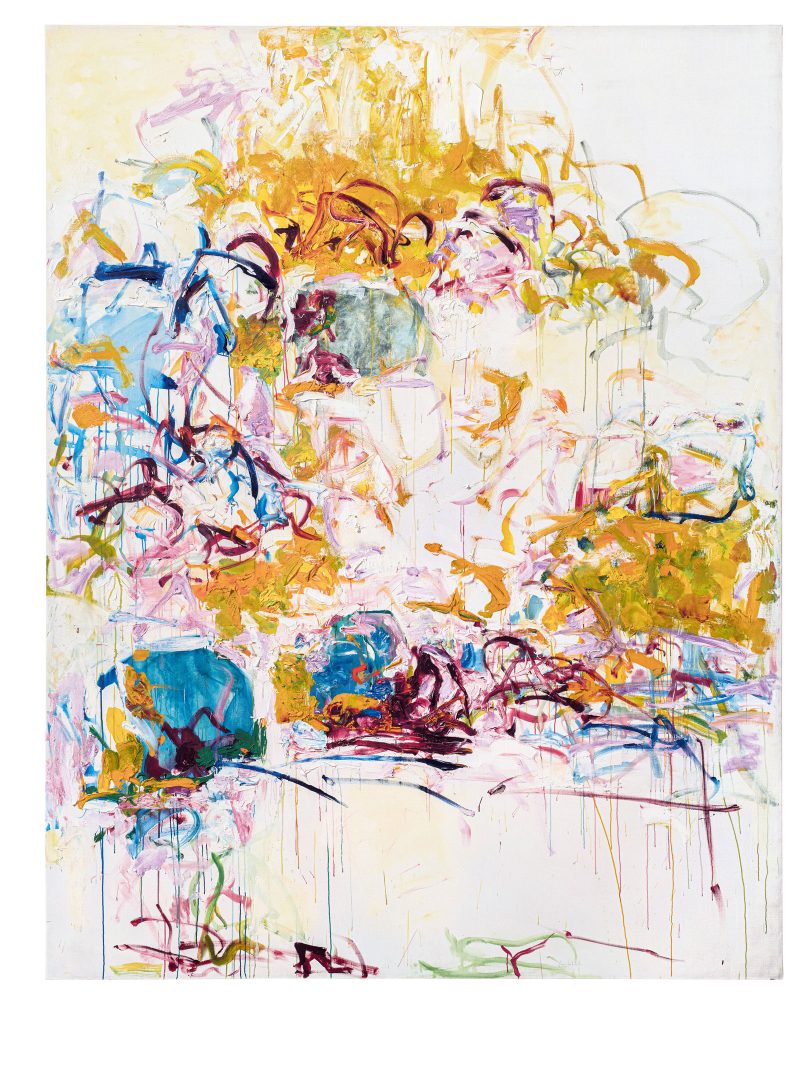
Footnotes
* “Beautiful Weed” in Sarah Roberts, Katy Siegel, Eds., Joan Mitchell, The San Francisco Museum of Modern Art in Association with Yale University Press, 2020, 12.
** Katy Siegel, ”St, Mark’s,” in Joan Mitchell, 31.
*** Éric de Chassey, “A Country of Her Own: Joan Mitchell and France, 1948-67,” in Joan Mitchell, 93.
**** Label text in the Baltimore Museum of Art (BMA) Joan Mitchell exhibition.
***** “Beautiful Weed” in Sarah Roberts, Katy Siegel, Eds., Joan Mitchell, The San Francisco Museum of Modern Art in Association with Yale University Press, 2020, 12.


